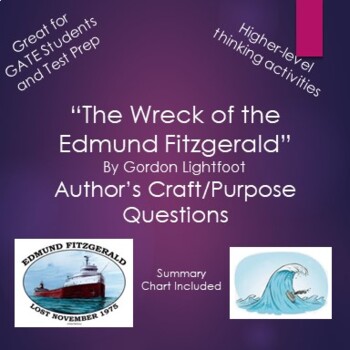The Wreck of the Edmund Fitzgerald Author's Craft/Purpose Questions
Karen Rohach - Author's Purpose Expert
86 Followers
Grade Levels
7th - 10th
Resource Type
Standards
CCSSRL.9-10.1
CCSSRL.9-10.2
CCSSRL.9-10.4
CCSSL.9-10.3
CCSSL.9-10.4a
Formats Included
- PDF
Pages
9 pages
Karen Rohach - Author's Purpose Expert
86 Followers
Also included in
- This unit consists of "The Wreck of the Hesperus," "Diving Into the Wreck," and "The Wreck of the Edmund Fitzgerald." Each piece contains higher-level thinking questions which require students to identify literary devices and strategies and determine the author's purpose. The unit also includes chPrice $5.00Original Price $7.00Save $2.00
Description
This song describes the tragic loss of twenty-nine men when the SS Edmund Fitzgerald sank in Lake Superior. The product contains higher-level thinking questions which require students to identify the rhyme scheme, literary devices, and various strategies used by the author to convey his message. A summary chart is included and answers are provided for all activities.
Total Pages
9 pages
Answer Key
Included
Teaching Duration
N/A
Report this resource to TPT
Reported resources will be reviewed by our team. Report this resource to let us know if this resource violates TPT’s content guidelines.
Standards
to see state-specific standards (only available in the US).
CCSSRL.9-10.1
Cite strong and thorough textual evidence to support analysis of what the text says explicitly as well as inferences drawn from the text.
CCSSRL.9-10.2
Determine a theme or central idea of a text and analyze in detail its development over the course of the text, including how it emerges and is shaped and refined by specific details; provide an objective summary of the text.
CCSSRL.9-10.4
Determine the meaning of words and phrases as they are used in the text, including figurative and connotative meanings; analyze the cumulative impact of specific word choices on meaning and tone (e.g., how the language evokes a sense of time and place; how it sets a formal or informal tone).
CCSSL.9-10.3
Apply knowledge of language to understand how language functions in different contexts, to make effective choices for meaning or style, and to comprehend more fully when reading or listening.
CCSSL.9-10.4a
Use context (e.g., the overall meaning of a sentence, paragraph, or text; a word’s position or function in a sentence) as a clue to the meaning of a word or phrase.



